When the US joined the Allies in 1917, the Admiralty requested the USN's aid in its campaign against Germany. While destroyers and submarines were urgently needed to fight the U-boats trying to strangle Britain, they also asked for a division of battleships to bolster the Grand Fleet in its campaign to bottle up the German High Seas Fleet. After much dithering, the Americans finally dispatched New York, Wyoming, Delaware and Florida in December under Rear Admiral Hugh Rodman, and they were designated the 6th Battle Squadron of the Grand Fleet. While they quickly adopted British signals and tactics, they were far short of British gunnery standards, and it would take months to resolve the situation. In the meantime, they were put to work, including being dispatched as escorts to the convoys running from Scotland to Norway, which received battleship escorts because of the threat of German surface raiders.
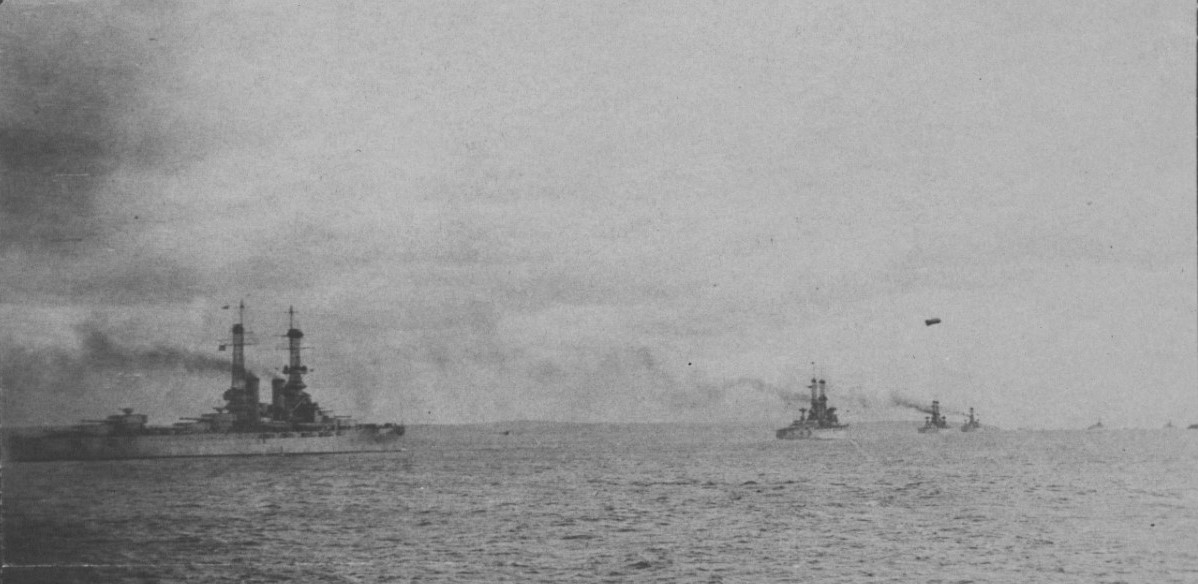
The 6th Battle Squadron sorties from Scapa
The threats to the Scandinavian convoy were apparently realized in mid-February, when British intelligence indicated that the Germans were at sea to intercept, and Beatty quickly led the Grand Fleet out into the teeth of a roaring gale. Delaware suffered significant damage from the heavy seas, with water passing through a voice tube shorting out her dynamos for half an hour before the crew managed to fix them. New York lost a man overboard, and Rodman reluctantly ordered no search be made due to the threat of the Germans. Unfortunately, the High Seas Fleet was riding out the storm in harbor, so the entire exercise was ultimately pointless. Early March saw the American ships covering another Scandinavian convoy, with the highlight being dense fog off the coast of Norway which led to signalling confusion and the squadron becoming separated for several hours.
Late February had seen further gunnery exercises, and the American fleet continued to turn in disappointing performances. Of particular note was Texas, holder of the Atlantic Fleet's gunnery trophy, whose shooting was considered poor by the British. Some of this was down to the rapid expansion of the USN in wartime, which had stripped experienced personnel to man ships coming out of reserve and filled their slots with new recruits. More had to do with the American method of carrying out gunnery at known ranges and allowing practice shoots before firing for score. The Admiralty, increasingly concerned about the threat of a German raid on the southeast coast of England, began to pressure Beatty to release a few dreadnoughts to bolster the defenses there, but he maintained that the Americans weren't up to the required standard yet. In April, the problem was more or less resolved by moving the Grand Fleet from Scapa south to Rosyth, near Edinburgh, where it could more effectively cover the East Coast against German raids.
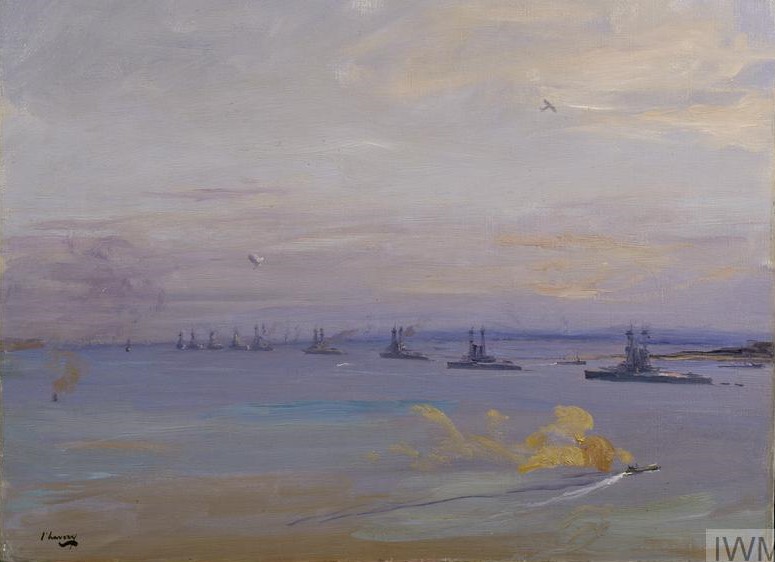
The 6th Battle Squadron in the Firth of Forth
Days after the Grand Fleet moved to Rosyth, the 6th Battle Squadron sailed on another convoy mission. As on the previous two, "submarines" were spotted and attacked, and as was typical of the North Sea in winter they ran into storms, which delayed the convoy a full 24 hours. This was the last time they would sail as the escort of a convoy, as the Germans had finally woken up to the fact that the Allies were practically inviting them to take a stab at a detached group of battleships, and sailed on the morning of April 23rd to intercept the next convoy. It was only the failure of German intelligence in picking up a change in the day of the convoy's sailing that prevented their plan from being successful. Fortunately for them, the British didn't pick up the sailing, as they had finally figured out how to evade British signals intelligence, and the only British submarine to sight the force misidentified it as friendly cruisers.
The Germans had originally relied on their their Zeppelins to find the convoy, but contrary winds had grounded them, forcing Hipper's battlecruisers to spread out and search. While detached, Moltke suffered a major engineering casualty. The inboard starboard propeller fell off, and the turbine driving that shaft ran away before the engineering crew could shut it down. The gear used to rotate the turbine to keep it from warping when cooing down blew to pieces, sending debris flying and damaging an auxiliary condenser. 1,600 tons of seawater began to flood into the compartment, and the damaged condenser allowed saltwater to enter the feed system, raising the possibility that she would be entirely immobilized.
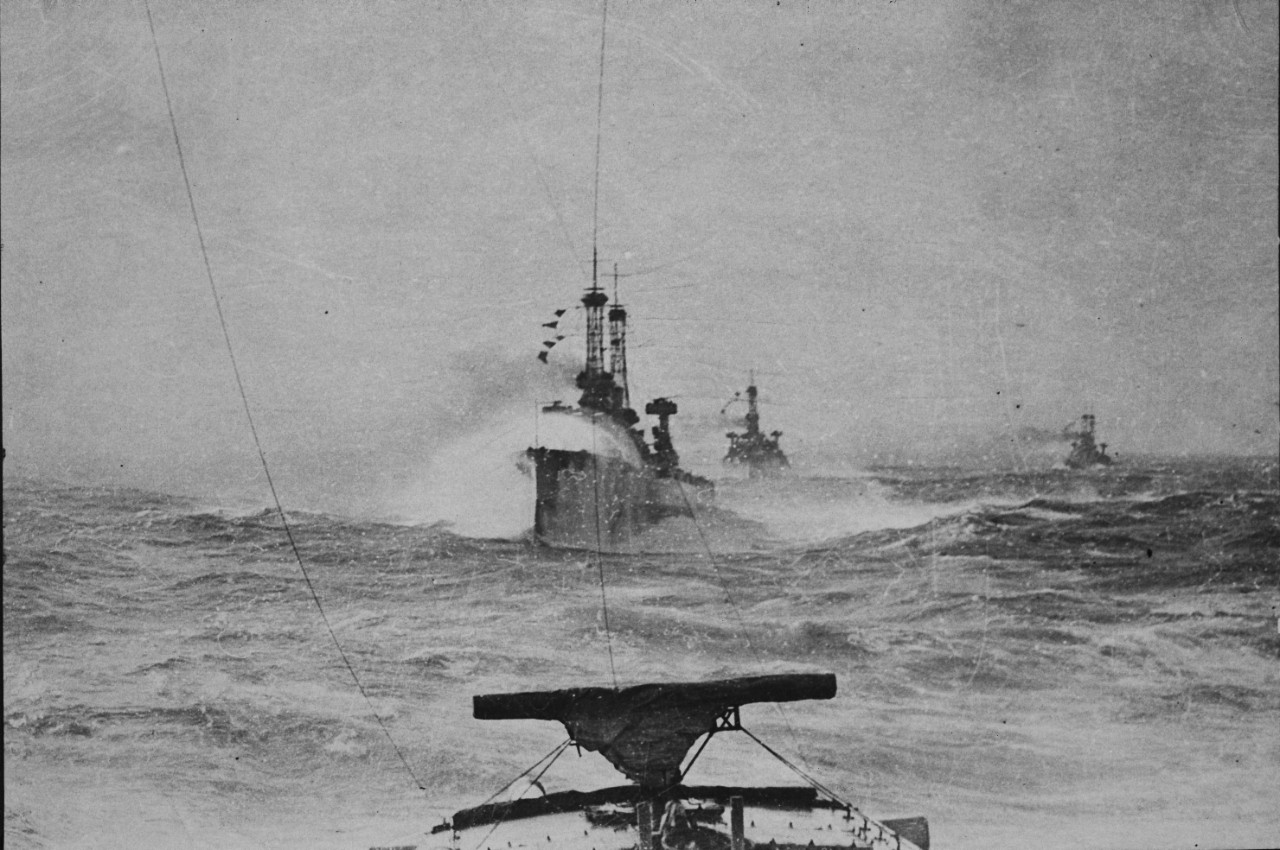
American Dreadnoughts patrol the North Sea
This disaster prompted Moltke to break radio silence at 0543 on the 24th, finally alerting the British that there were German capital ships at sea, at about the latitude of Scapa Flow itself. Scheer quickly turned the main body of the High Seas Fleet to aid the stricken battlecruiser, while the British spent several hours trying to confirm the information, finally ordering Beatty to sea at 1047. Despite the thick fog in the Firth of Forth, the entire Grand Fleet had sailed within three hours, the first time since August 1916 it had been ordered to sea en masse.
Unfortunately, it was too late. The Germans finally realized that they had missed the convoy around 1500 and turned for home, while battleship Oldenburg took Moltke under tow. Her engineers had worked miracles to purge the saltwater from her feed system, and through a combination of the two working shafts and the tow, she was able to make 10 kts or so. The British learned of this turn and informed Beatty within the hour, and he pursued into the next day in hopes of catching the Germans. It was not to be, thanks to excellent weather, which allowed Moltke to be towed at high speed. It wasn't until the afternoon of the 25th that she finally cast off, when the High Seas Fleet was well into the Heligoland Bight. She then ran straight into another disaster, as British submarine E42, laying in wait for the returning Germans, managed to pump a torpedo into her port engine room, allowing another 1,800 tons of water to flood in. Despite this, she survived, and her engineers somehow managed to keep her from losing power entirely. It would be September until she was fully repaired. The British, who never got closer than 150 miles, retired during the 25th. The next time both fleets put to sea, it would be for the Grand Fleet's triumph as the High Seas Fleet sailed into internment.
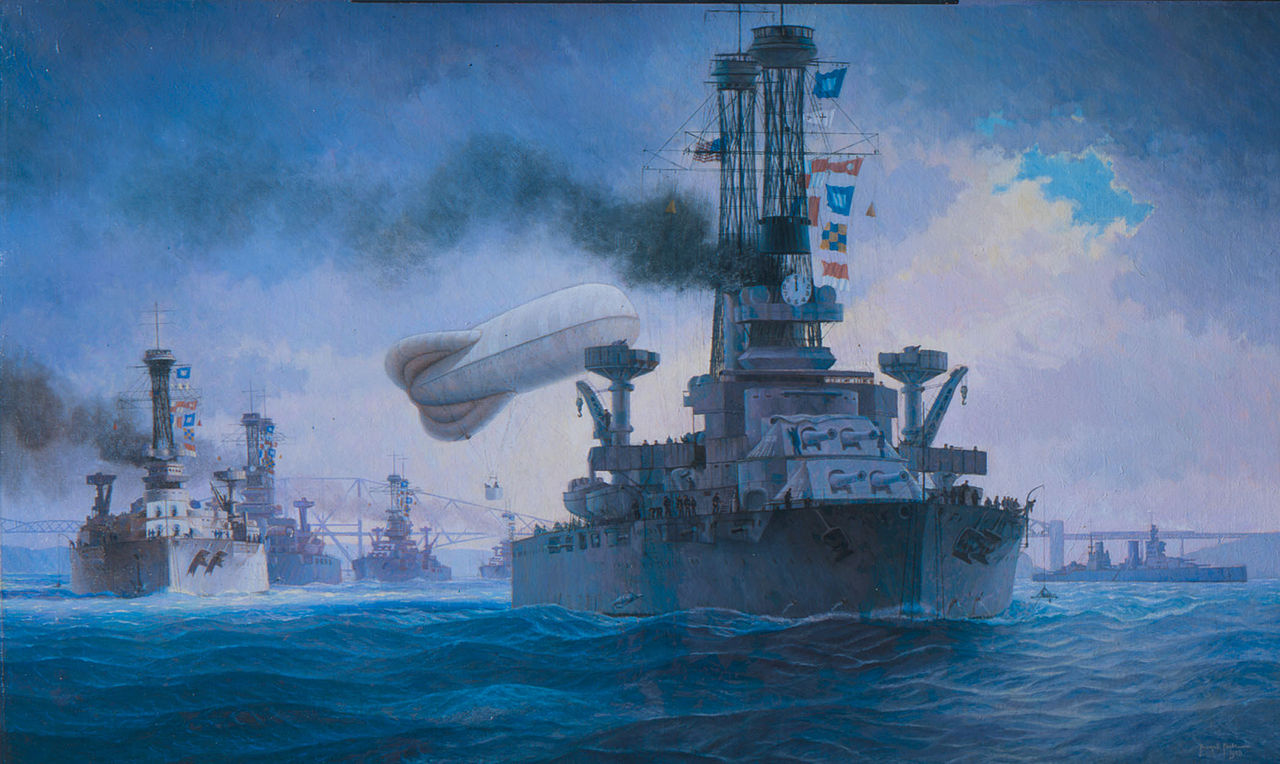
The ships of the 6th Battle Squadron sail from Rosyth
But the Allies didn't know that yet, and Admiral Rodman remained concerned that the Germans would launch another sortie and pick off the escort. Sims rebuked him for bringing this up, claiming it would strain relations with the Admiralty, but the same logic must have been apparent to them. In June, the escort was reduced to a light cruiser squadron, later strengthened with a pair of obsolete armored cruisers. These were strong enough to deal with the raiders that had previously hit the convoys, but not too valuable to risk, and they stood a decent chance of being able to escape in case the High Seas Fleet came back.
By mid-1918, the US battleships had become an integral part of the Grand Fleet. Their gunnery was finally satisfactory, and relations between the officers within the fleet were excellent. Because the USN and RN used different promotion schemes, Rodman was still a Rear Admiral, junior to all of the other Battle Squadron commanders and some of the commanders of the Light Cruiser Squadrons. Beatty asked that he be promoted, as he believed that the Battle Squadron's CO should lead the task force, but the Americans turned him down, likely due to Woodrow Wilson's suspicions of foreign interference. In practice, this was dealt with by the British officers agreeing to waive seniority in cases where Rodman would have been the force commander.
On June 30th, the American dreadnoughts once again put to sea, this time as escorts for the laying of the first batch of mines in the North Sea Mine Barrage. The classically American plan involved laying a continuous net of 70,000 anti-submarine mines from Scotland to Norway, bottling up the U-boats in the North Sea. The trip was marred only by a few reported U-boat sightings (as usual, the only U-boat in the area was not involved) and a few of the mines breaking loose to menace the fleet, which was a cause for serious concern. Rodman's ships returned to base in time to celebrate the 4th of July, with many of his sailors going ashore on liberty. Despite the lack of alcohol aboard ship, their behavior on shore was often complemented throughout their time in Europe, with the only notable problem being a large number of venereal disease cases after refits in Newcastle. The Americans also participated in inter-fleet sporting competitions, including capturing the lightweight and middleweight trophies during the boxing championship.
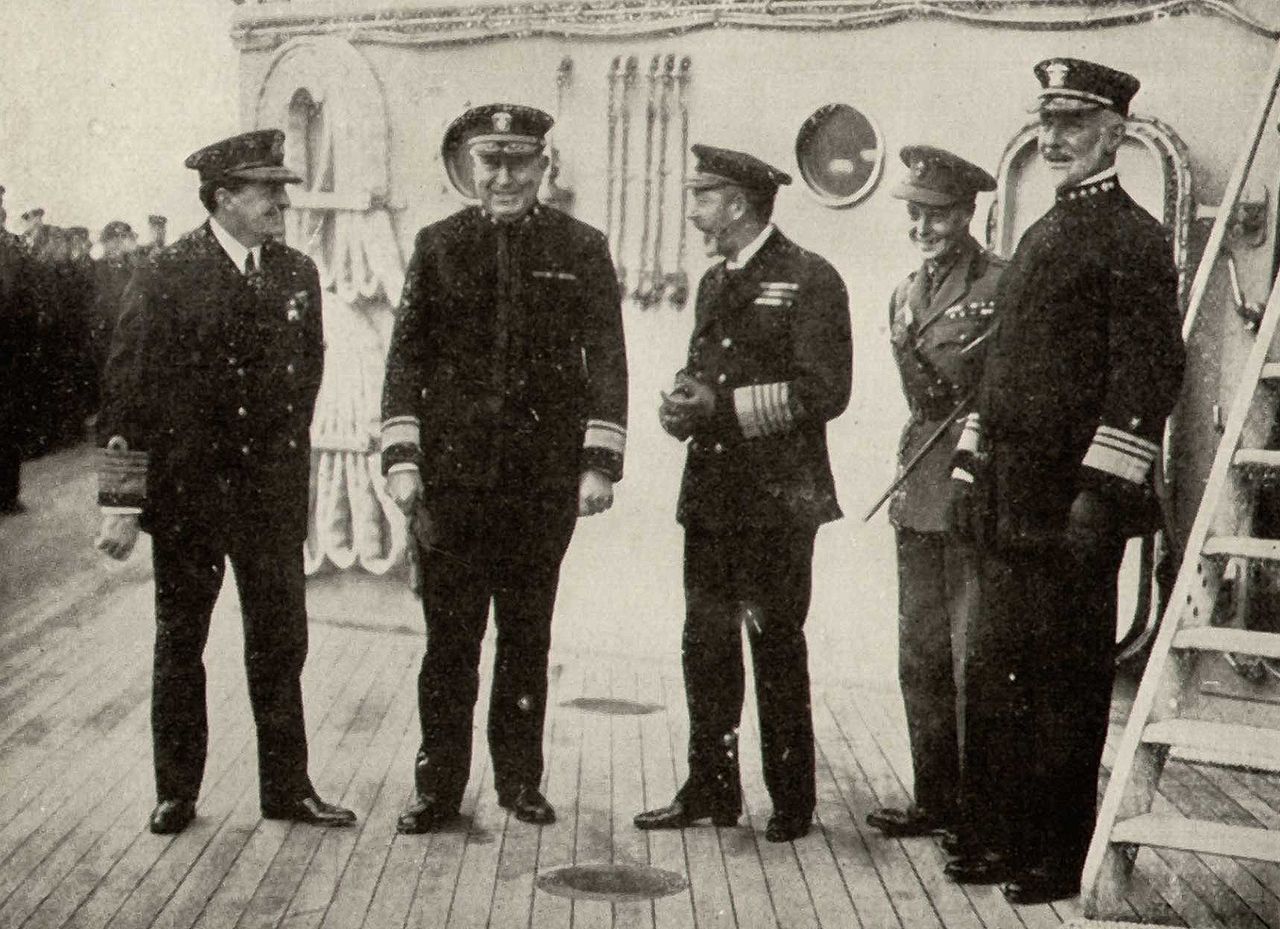
Beatty, Rodman, King George V, the Prince of Wales (later Edward VIII) and Sims
July also saw two royal visits to the Grand Fleet, first by the King and Queen of Belgium, who spent an hour aboard New York, and then by George V, who honored Rodman with a knighthood, despite Rodman's refusal to kneel. He then came aboard New York for an inspection, where he told Rodman that "your fire-room is as clean as a dining-room", a high complement for a room where coal was shoveled into boilers. He even agreed to shovel some coal himself, to the cheers of the American stokers, before retiring for further conversation with Rodman, which he appeared to enjoy immensely.
Rodman's request for Arkansas to replace Delaware had finally made its way through the Navy Department, and she sailed from Hampton Roads on July 14th with 14 members of the House Naval Affairs Committee onboard. Their passage was mostly uneventful, but a day out from Britain, lookouts reported a submarine and torpedoes. Arkansas dodged, although the British destroyers escorting her were skeptical that anything was there, prompting some friction between the two sides. As you'd probably expect by now, the escort was correct, and no submarine was in the area. Arkansas reached Rosyth on the 29th, and Delaware departed the next day, bound for home. On August 8th, the American battleships sortied in company with the Queen Elizabeths of the 5th Battle Squadron to cover more minelaying efforts. During this effort, Florida reported a submarine contact, which her escorting destroyers failed to take entirely seriously, landing them in trouble with Hugh Evan-Thomas, commander of the Fifth Battle Squadron and the force as a whole.
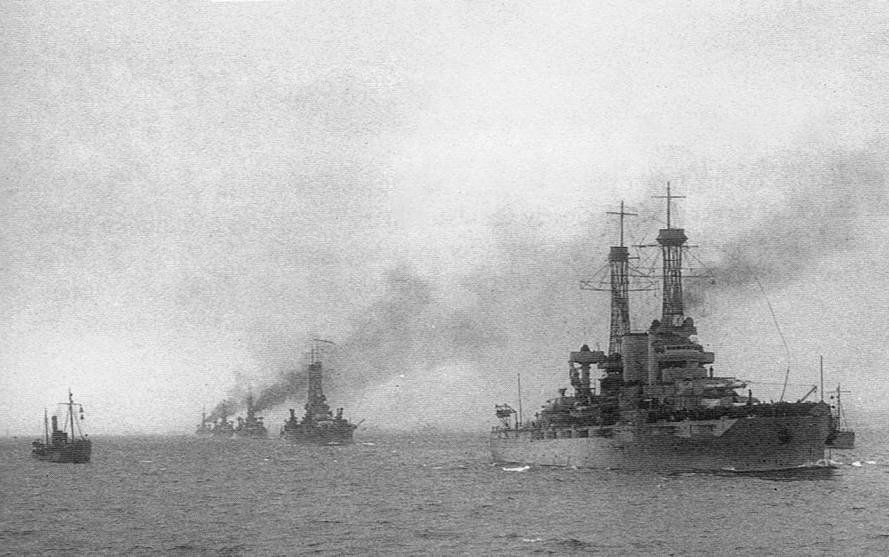
The American ships in the Firth of Forth
The Grand Fleet went to sea for maneuvers later in August and again in September, both times reasonably successfully. On October 12th, reports came in that German raiders were loose in the North Sea, and the 6th Battle Squadron sailed in company with other ships to make sure they didn't slip around the northern tip of Scotland. The weather was horrible, and the reports of raiders were false, but the sortie did provide the only actual contact between the American dreadnoughts and a U-boat. While steaming back into Scapa around sunset on the 14th, New York ran into something underwater, hitting first on her starboard quarter and then with her propeller, which lost two blades. As she was in a 200' deep channel, it was clearly not a wreck, so the only plausible conclusion was that she had hit a submerged U-boat, probably hard enough to sink it. Surprisingly, the U-boat has not been located, but two vessels, UB-113 and UB-123, were lost to unknown causes at about the right time. New York had to go to Rosyth for repairs, and on the way, three torpedoes were sighted passing ahead of the battleship. Their origin isn't known, and it's likely they missed because New York was limited to 12 kts instead of the standard 16 and her attacker overestimated her speed.
New York's potential submarine kill1 was the last major excitement for the men of the American dreadnought squadron before the Armistice. Gunnery practices continued, with all of the ships except Arkansas now putting on a credible showing. Late October saw the arrival of an unwelcome visitor to the Grand Fleet, the Spanish Flu. All of the ships suffered to some extent, with two battlecruisers being so badly hit that they couldn't man their boilers and had to get steam from tugs. Among the Americans, Arkansas was most affected, with 259 cases and 11 deaths by November 9th from a crew of about 1,060. On the Western Front, the German Army was at the point of collapse, and an attempt on October 24th to send the High Seas Fleet on a last, doomed sortie instead prompted the crews to mutiny. It soon spread ashore and across all of Germany, bringing down the Kaiser and prompting the new government to ask for an Armistice, which was signed on November 11th.
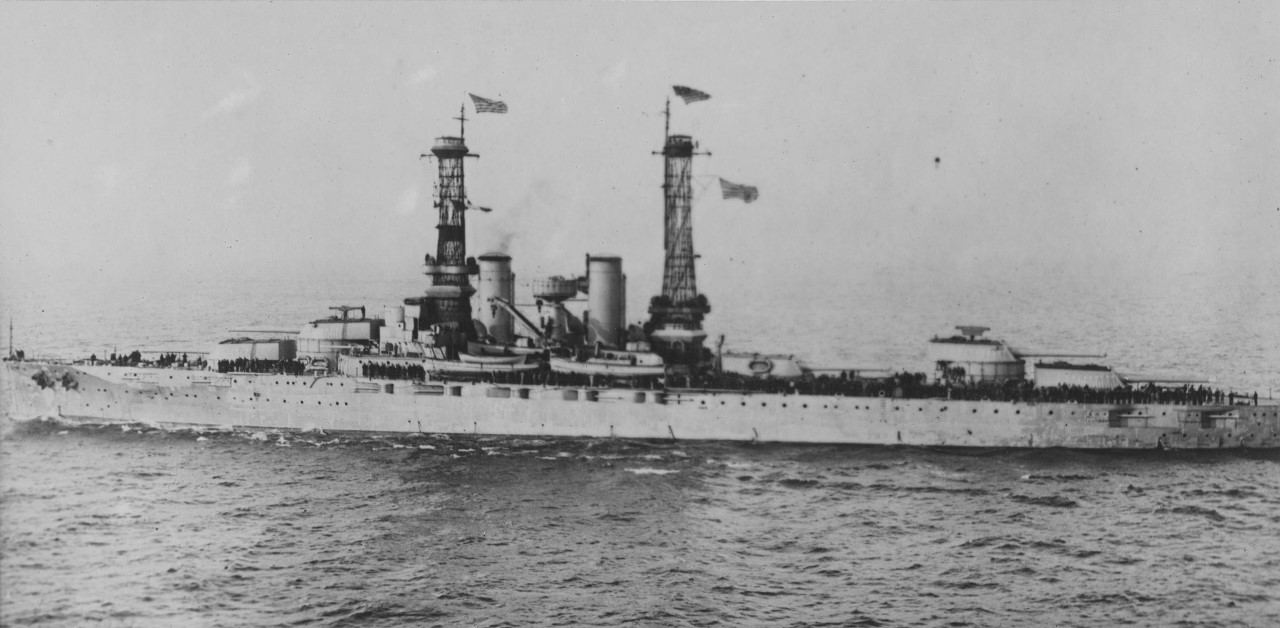
New York, decked out for the arrival of the High Seas Fleet
One of the conditions of the Armistice was that most of the ships of the High Seas Fleet would be interned by the British, and on November 21st, the Sixth Battle Squadron sailed with the rest of the Grand Fleet to meet them as they came into the Firth of Forth. Bedecked in all available flags, the American sailors watched the vessels they had waited for for nearly a year steam into captivity. They had played their part, and before long, they would be on their way home. Departure day was December 1st, and Beatty and Rodman exchanged signals stating the high regard the two men and fleets held each other in.
Although they never saw action (except by accident) the deployment of the American dreadnoughts to the Grand Fleet was a success, and one of the most important contributions the USN made to the Allied effort in the First World War. As much as anything, it was the first time that the two great navies had worked closely together, and the bond they formed would be refined two decades later when they found themselves again battling Germany for control of the Atlantic. The credit for this primarily belongs to David Beatty2 and Hugh Rodman, both of whom strove to make the integration of their forces as seamless as possible, despite the hostility many in both navies felt towards the other. This foundation, built upon across a century of war and peace, has endured and forged a partnership like no other in naval history. In many ways, the greatest tribute to their efforts can be seen in the 2021 deployment of the group built around the carrier Queen Elizabeth, named after Beatty's flagship.3 It included as integral parts both destroyer USS The Sullivans and Marine Fighter Attack Squadron 211.
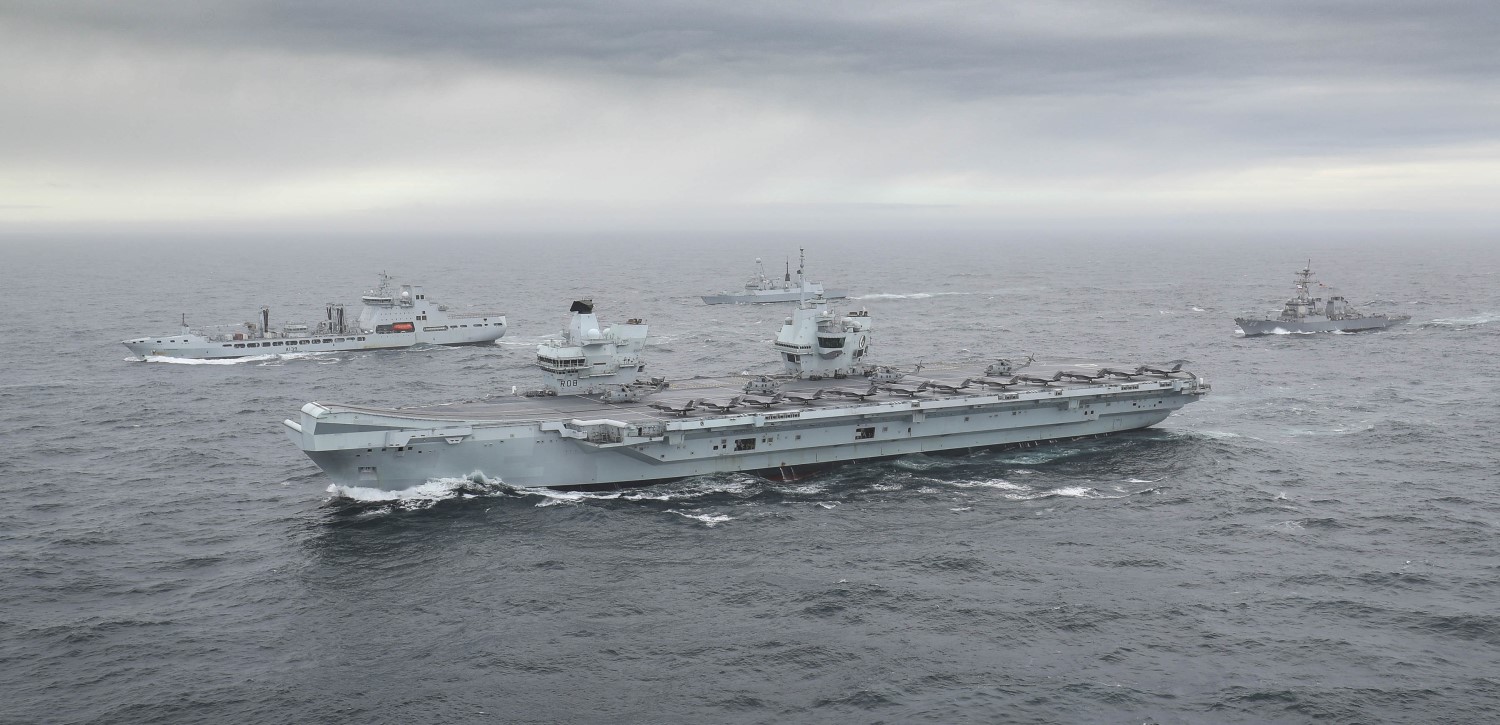
1 The only dreadnought with a confirmed submarine kill is actually Dreadnought herself, who rammed U-29 in March 1915. ⇑
2 Beatty's feelings towards the Americans were surprisingly complex. He went to great lengths to make them feel welcome, but many of his personal letters show great concern about their combat-effectiveness even into June. I'm well-known not to be a big fan of his, but to his credit and whatever his feelings, he got the integration of the American ships completely right. ⇑
3 And also after the current Queen, although they're trying to pretend it isn't. ⇑

Comments
Another reason for the Armistice is that the Austro-Hungarian Empire had already collapsed, and on November 4th signed an Armistice with the Kingdom of Italy, which, among the various clauses, granted the use of the Austrian railways to the Regio Esercito, allowing them to open another front, this time on the southern frontier of Germany, which was mostly undefended.
Just wondering ... did the two sides pick up anything about naval design or ship handling from each other, besides gunnery practice?
@Emilio
This was really not an attempt to get a complete theory of the reasons behind the Armistice. There was a lot of interlocked collapse going on throughout the Central Powers, and I suspect that the situation in Germany had a lot to do with the Austro-Hungarian Armistice, which in turn did push Germany to also give up. But the revolution sparked in the HSF was definitely one of the immediate causes, and the appropriate one to highlight here.
@Tony
They did. Reports from the British on American practice are important in Friedman's discussion of these battleships, for instance. Both sides seemed reasonably happy with their practices afterwards, but there were ideas flowing back and forth. I just didn't want to try to cover all Anglo-American naval cooperation for reasons of scale.
How come the Germans, when they could not use the Zeppelins to find the convoy, didn't wait for the next convoy? A single Zeppelin should be able to scout the water between Norway and Scotland with a reasonable likelihood of success (assuming good weather)?
Also, thanks. I thought I knew most naval history, but this was new to me.
I'm not really sure. My guess would be that they didn't think it was that important and were still mostly operating in a mental frame where the Zeppelins were a nice to have instead of a big deal. Experience so far during the war didn't seem like it would have cured them of that. Zeppelins had participated in the Sunderland operation, but they hadn't exactly covered themselves in glory, and with that experience, I could easily see Scheer deciding not to bother.
How bad was USN shooting that the Royal Navy thought they sucked? The Brits only got about a 2% hit rate at Jutland and the Falklands with Beatty preferring to smother the enemy with shells and overload his ships with shells. The Germans were ~3-4%. Did the Brits git gud at some point after Jutland or were the Americans that much worse?
Perhaps this was mentioned in a post on UNREP but how do you get steam from a tug into a warship? I presume this is low-pressure stuff used for various things across the ship rather than what drives the engines.
@Jack
There's still a lively debate over British performance at Jutland. Yes, Beatty's ships shot pretty badly in the early part of the action, but they had bad visibility and there were also some deeply impressive performances by the Grand Fleet. Iron Duke broke 10% during the first crossing of the T, IIRC. They also made substantial improvements after the battle.
@Lambert
You use a hose/pipe. It's pretty common for a ship alongside to draw services from the shore, and in this era, that meant steam as well as electricity. It's not main propulsion steam. In the WWII USN, it would have been 150 psi auxiliary steam instead of 600 psi superheated main steam for the engines. Don't recall what the RN used, but it was something of that nature.
This is petty, but..."British submarine E42". What the heck? I thought the Brits were generally best in class at naming their ships!
Submarines weren't ships. When submarines were first introduced (less than 20 years before this) they were very small and short-ranged, more like boats than ships, and they were numbered that way. Nobody I can think of gave submarines proper names until the interwar years.
There's a sign of how much things change, isn't it - now both the USN and the RN name subs with former capital ship names! (And unlike the execrable use of city names for corvettes or for supply ships(*), I'd argue modern SSNs and SSBNs do deserve to be thought of as something akin to capital ships.)
(*) - USNS City of Bismarck, WTH. Talk about a missed opportunity. Bismarck may be the most forgotten capital city in America and BB Bismarck may be the most overrated battleship ever, but come on, couldn't we have arranged to have USS Bismarck as a major surface combatant? Even if that means a Tico or a Burke - closer than a non-commissioned expeditionary transport!
I think a non-commissioned transport is exactly the right ship to call USS Bismarck. But yes, big changes, and I don't really object to designating the submarines as capital ships. (I object to not naming them after historic and memorable American submarines, but that's a different issue.)
Admittedly, I mostly want a combatant USS Bismarck just to poke wehraboos in the eye, and I suppose an MSC ship achieves that end even better.
"Fish don't vote" - some annoying engineering officer ;)
Also, submarines still aren't ships, they're boats! (TRADITIOON! Ahem)
My greatest submarine naming disappointment is that there was never (and will likely never be) an SSBN named after the Sooner State
Count me among those who wanted (want) a cruiser named USS Bismark.
Jade described my logic perfectly. The idea of USS Bismarck is hilarious, and it's even more amusing when it's MSC.
No more jacking the shaft for Moltke, I guess.
On the subject of Rodman and rank, would be curious if there was any discussion about breveting him; while the process was long in disfavor by that time after the Civil War, it was still used (notably, Tasker Bliss became a brevet general so he could socialize better at the post war parties and peace conferences.
I'm not sure if the USN has ever used Brevets in quite that way. Frocking isn't the same and wouldn't apply here. On the other hand, I think of Husband Kimmel, who had a temporary four-star rank while in command of PACFLT, but was reduced to his permanent two-star rank when he was removed. I'd guess that they didn't do that for Rodman because it would have required making the command of BatDiv 9 a three-star position, and that would be out of line with other, similar units. Also Anglophobia.
So far as I'm aware, all current USN O-9 and O-10 billets are temporary promotions, and if an admiral that held them transfers out without retiring, they'll be reduced back to O-8. That's pretty rare, as most admirals who hold a VADM or ADM billet will retire if they're not selected to another, but as I recall that's how the rule is written.
Hmm. I might have heard that, although the intricacies of the USN promotion system aren't my thing. But if so, then that pretty clearly rules out doing that for Rodman, as he would have been de facto promoted even under that system because they would have had to increase his billet.
I think all the services except the Coast Guard do that currently. (Well, and it might be too soon to tell for the Space Force - any of their O-9 or O-10 officers haven't had a chance to retire yet that I'm aware of.)
Space Force O-9s and O-10s will be required to end their careers by being demoted to Captain and sent off on One Last Mission. Traditions must be upheld.
Fun fact, the most famous recent example of an Admiral not making it to Time in Grade requirements for O-10 is Former ADM (and former Congressman) Joe Sestak, who was fired by Mike Mullen on Mike's first day in office (which was pretty high on the list of the "Good things done by Mike Mullen").
Huh. I'd read his wiki article before and been baffled by some of his positions, but missed the bit about retiring as a 2-star.
I'm always willing to believe that Former Congressman is indicative of somethingsomething, but I would like to know more about why Mullen firing Sestak was A Good Thing. (A browse of his Wiki article suggests "wanting to shrink the fleet" might be A Reason)
I lived in Sestak's district during his time in Congress, was a volunteer in his campaigns and met him a few times.
He impressed me as a man I would want in command sailing into storm or battle, and I'd vote for him again. Note that he's the highest-ranking military officer ever elected to Congress.